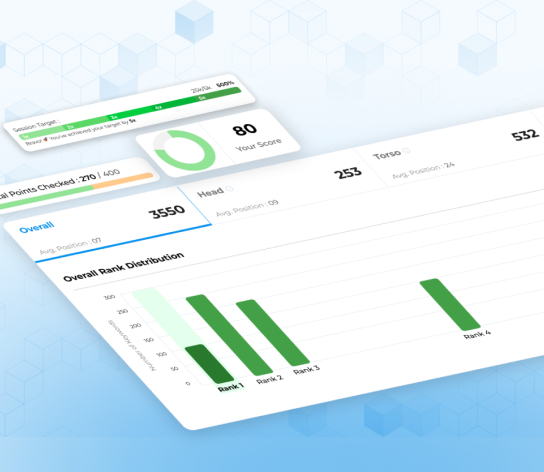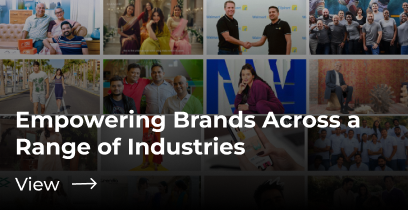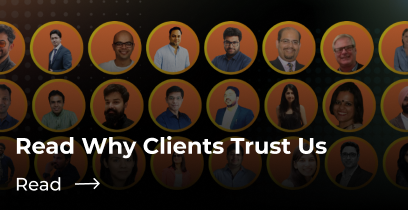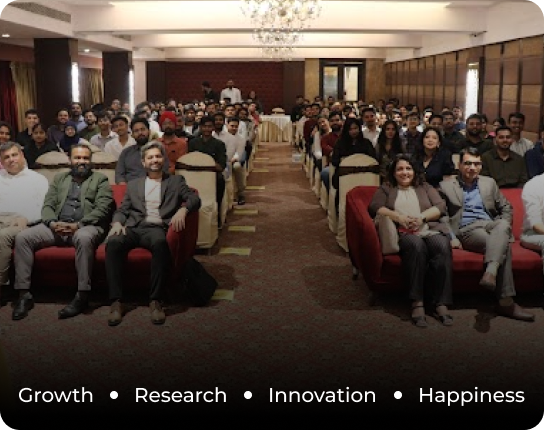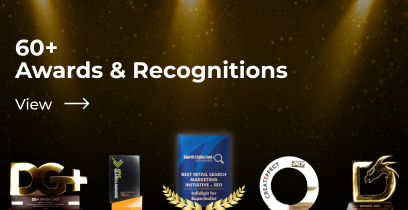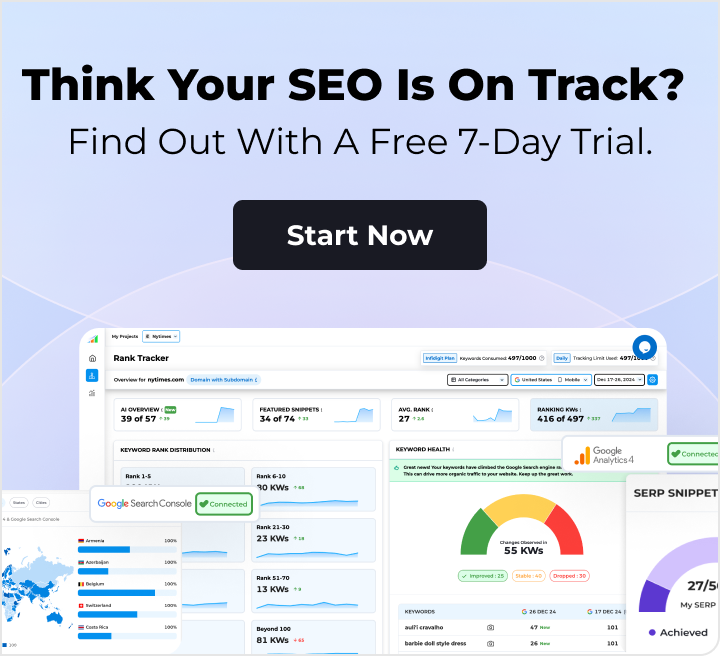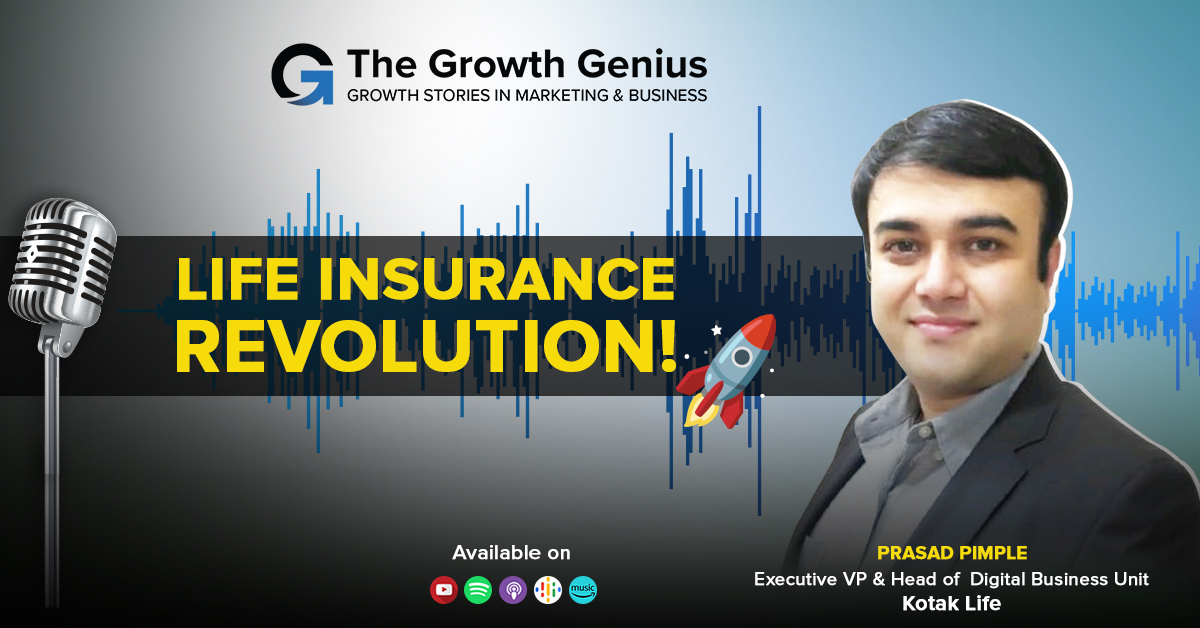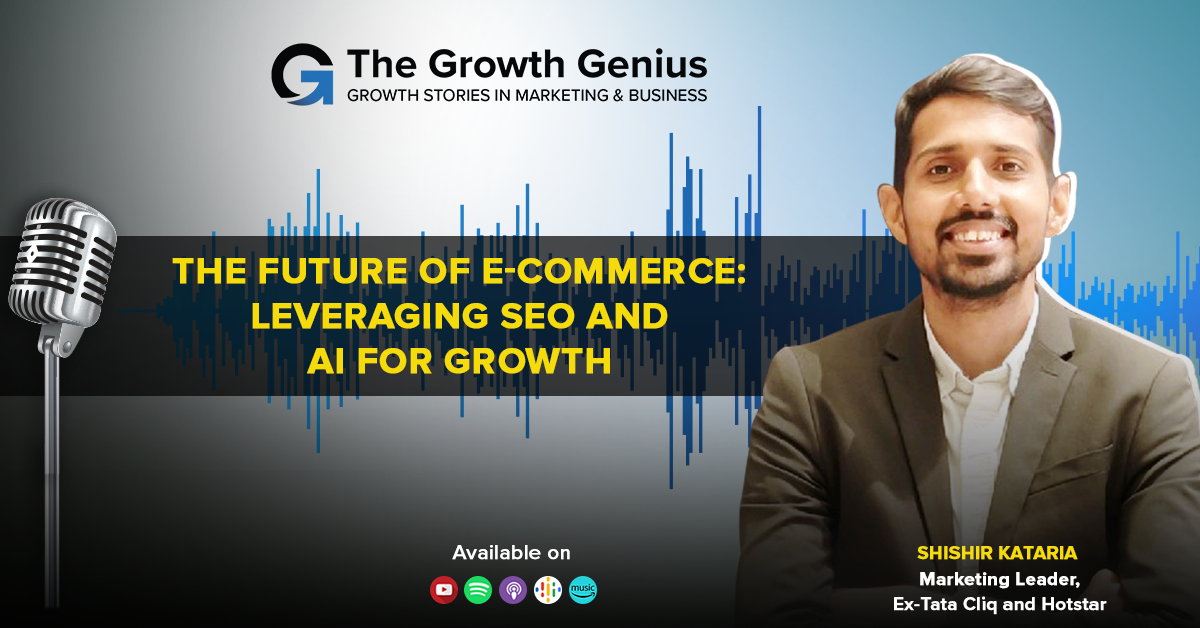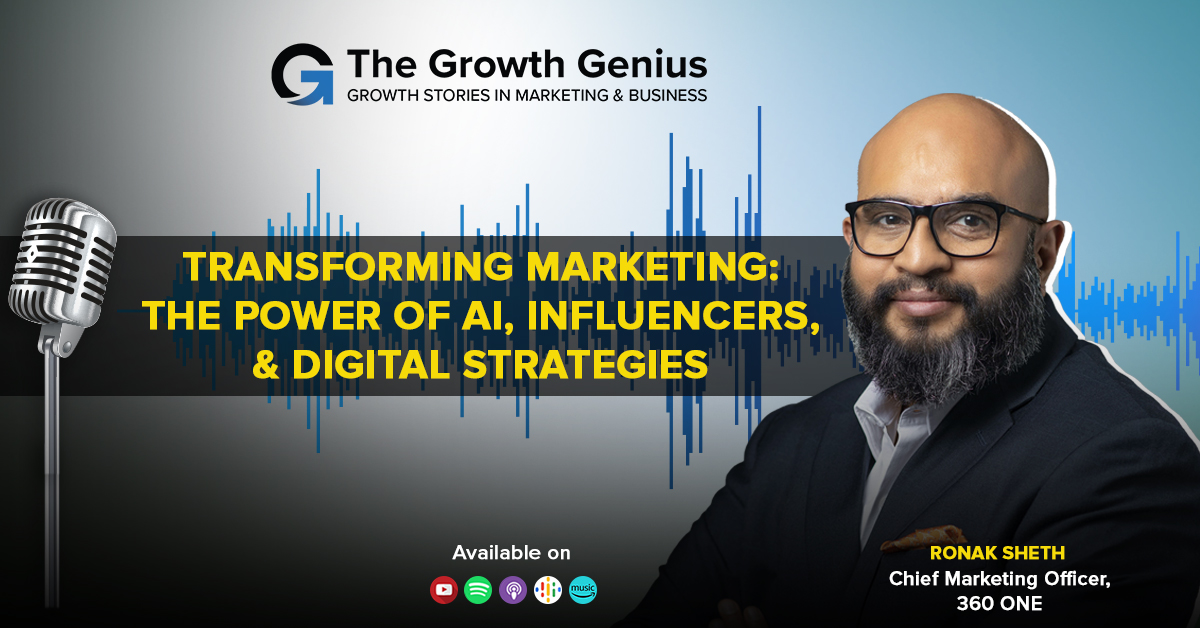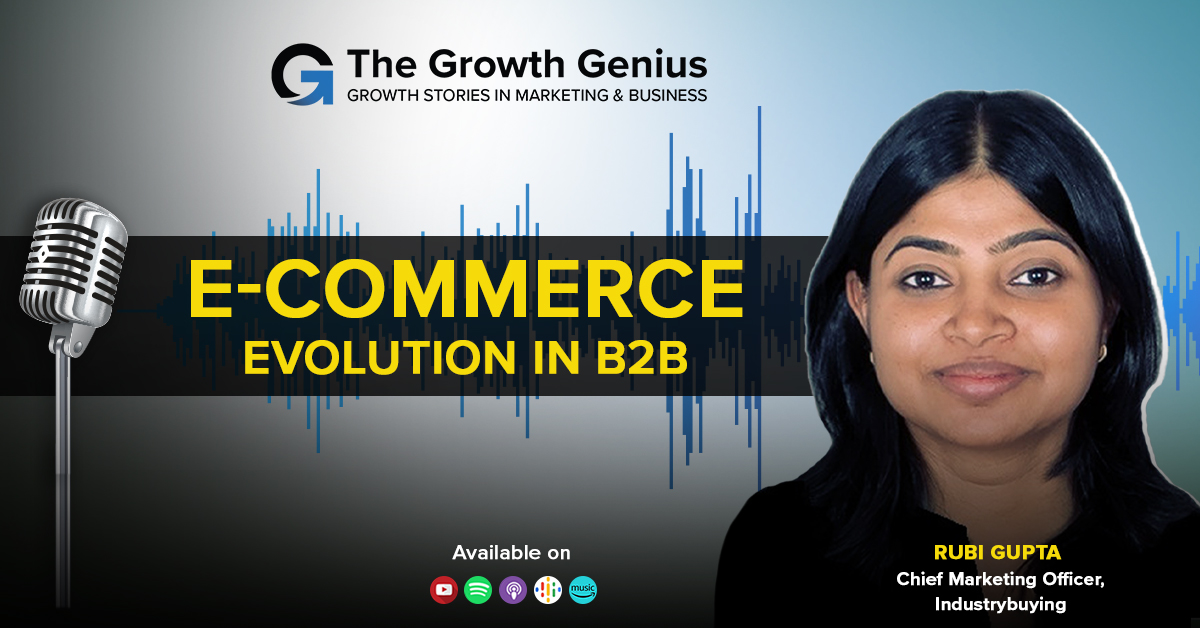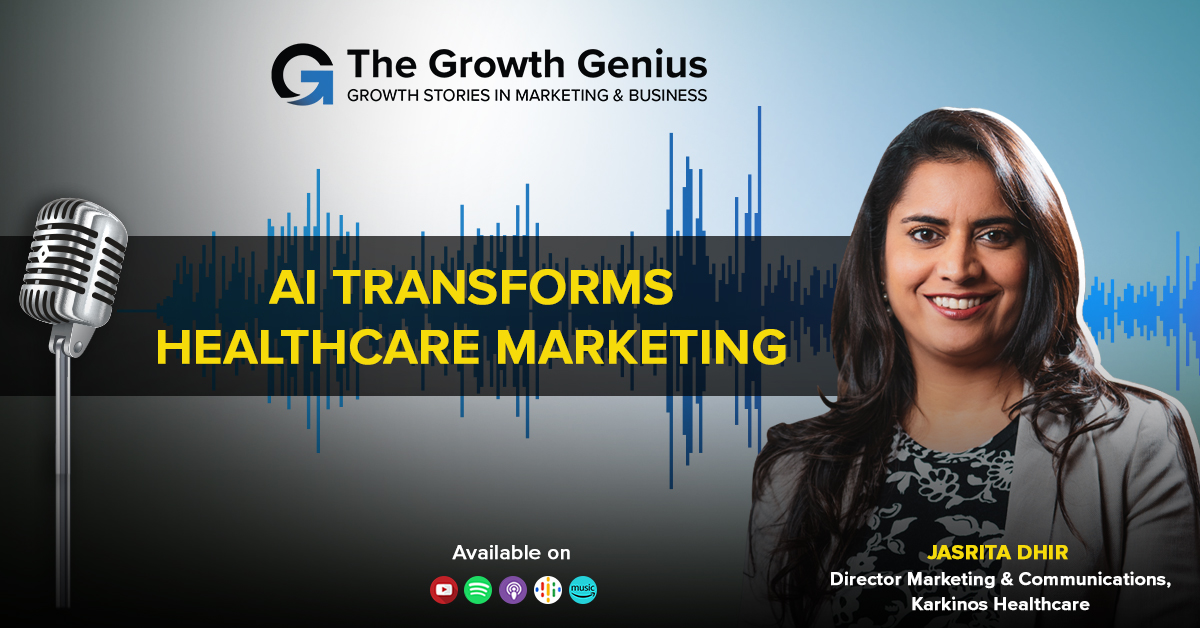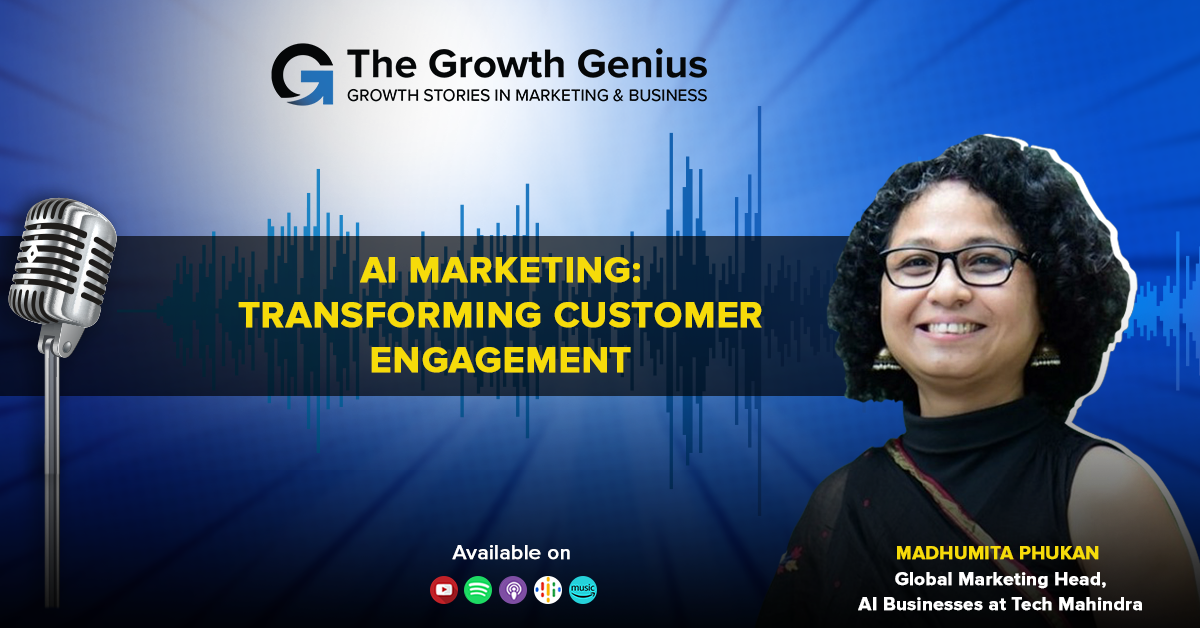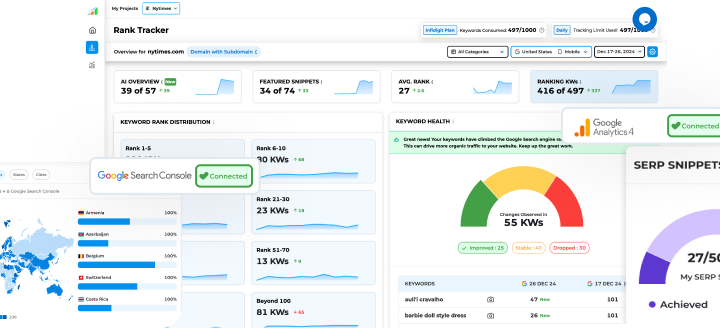Listen on your Podcast app
Summary
Pankaj Soni, VP Marketing at Spinny, shares valuable insights on driving e-commerce growth in today’s competitive market. With a focus on customer-centric strategies, Pankaj emphasizes the importance of blending data-driven decision-making with genuine consumer empathy. He highlights how understanding evolving customer behavior, leveraging the right digital channels, and continuous experimentation are key to scaling online businesses. Pankaj also discusses the role of brand trust and transparent communication in building lasting customer relationships. By combining performance marketing with creative storytelling and consistently optimizing user experience, brands can unlock sustained growth. His practical tips and real-world examples offer marketers actionable ideas to refine their strategies and stay ahead in the dynamic world of e-commerce.
Key Take Aways
- Customer-Centric Approach: Prioritize understanding and addressing customer needs to enhance satisfaction and loyalty.
- Data-Driven Decision Making: Utilize analytics to inform strategies and optimize marketing efforts effectively.
- Omnichannel Marketing: Ensure a consistent brand experience across all digital platforms to reach customers wherever they are.
- Performance Marketing: Focus on measurable outcomes to assess the effectiveness of campaigns and adjust tactics accordingly.
- Creative Storytelling: Engage audiences by crafting compelling narratives that resonate and build brand identity.
- Continuous Experimentation: Adopt a test-and-learn mindset to innovate and stay ahead in the dynamic e-commerce landscape.
- Building Brand Trust: Foster transparency and reliability to establish long-term relationships with customers.
- Optimizing User Experience: Continuously refine the customer journey to improve satisfaction and conversion rates.
Read Transcript
Pankaj Soni:- a brand like Spinny cannot be built only using advertising should I buy a car from you right now because I’m going to run that car for the next 3 4 years are you going to be there or not because you’re giving me a warranty who is going to fulfill that warranty players like Marauti and Mahindraas they were buying their old cars because they have to sell the new ones.
Mehul Ashar:- Welcome ladies and gentlemen to yet another episode of the growth genius this is where we bring to you growth stories in marketing and business powered by infidigitl e-commerce and digital marketing is a very interesting space to be in and our growth genius for today works in exactly that space he has worked with brands like Google and Snapdeal among other reputed brands and now he heads marketing for an e-commerce platform called Spinny as we all know Spinny is a platform for buying and selling used cars so join me in welcoming Pankaj Soni VP marketing at Spinny pankage welcome to the Growth Genius podcast it is a pleasure to have you here glad that you could take out time uh for this podcast.
Pankaj:- Pleasure is all mine, yeah, thanks, thanks for the opportunity.
Mehul:- Pankaj wanted to understand, you know, how do you define your role at Spinny?
Pankaj:- So I uh I head the marketing team for Spinny. Wherever you see the ads of Spinny, you can hold me responsible for that.
Mehul:- So this is uh predominantly anything and everything uh under marketing, so is it like you know offline online all of it?
Pankaj:- Yeah, yeah, offline online everything digital, including the SEO and the direct messages that you get in your mobile phones and devices, all of that put together.
Mehul:- Wonderful, wonderful, thanks Pankaj, your professional life has transitioned across various brands you have worked across various industries, so can you elaborate you know on your journey?
Pankaj:- It’s been a long journey and uh multiple brands multiple roles uh but largely I spent a large amount of time in uh uh digital advertising and marketing roles and uh you know uh I started off with a government uh organization small industrial development bank uh sometimes I wish I would have never moved on uh but you know uh things uh fate had a different plan and uh I’ve been with uh I’ve been with snapdeal.com in their growth years uh a longstanding there uh and Info Edge like you know one of the uh very interesting uh uh digital first listed uh company in India and I spent some time with Google uh in the India sales team and then now I’m with Spinny heading marketing uh for Spinny uh so yeah uh various roles uh across uh digital advertising across uh marketing and uh a couple of sales stints that’s pretty much the journey and uh tell me what more do you want to know.
Mehul:- Yeah, so I’ll go on to the next question, you know, I basically want to understand your perspective on the changing consumer needs, specifically in the automobile industry?
Pankaj:- See we we are in a used car uh retail business so so we buy from the market we refurbish them and we uh sell used cars uh back to the market and the decision making uh is actually quite different when when people are choosing between a new or a used car typically the consumer is common but the decision making uh the people involved in decision the families and friends and all all of that makes there is a bit of a difference uh in how people decide a new car versus a used car what I see happening now and especially uh with players like Spinny uh structuring and organizing the overall market is a renewed trust or actually a new found trust in buying a used car so I think that has been catalyzed by a player like Spinny if you have came across any of your friends who have tried buying a used car in the past there was always a doubt on you know what the meter readings of the car tells us what the mechanic assessment of the car or the dealer is telling us so people would usually take along a mechanic with them you know sometimes the mechanic might turn out to be in cohorts uh with the dealer itself so it was a very low trust industry and uh you know another thing that has changed the dynamic uh significantly is how the road infrastructure has improved over time uh how people have become a little more serious about maintaining the new cars all of this brought together and a player like Spinny catalyzing that trust on buying a used car has significantly gone up what we have started to see is a large amount of our uh car buyers are firsttime car buyers you know more than three fourth are are like that a lot of them are Gen Z so people who are buying their first cars or people who are buying their uh cars after their first job are usually our customers and and that trend has significantly changed people wouldn’t buy their first cars until uh you know long into their careers that is changing so so that age is kind of decreasing with the used car market becoming bigger and uh I think what else has also changed is uh there is a larger supply in the market now the volume of new cars that have been sold in the last 6 to 7 years are now coming back to the market you know that’s how the cycle is people try and refresh their cars every 3 to 5 years and when they are refreshing they have to sell their old cars typically players like Marautis and Mahindras they were buying their old cars because they have to sell the new ones but where would these cars go they were going uh to the rural markets they were going to you know uh satellite cities but a lot of people within larger cities are now buying used cars as their first car and uh the supply of used cars in the market has also catalyzed this particular change of course there is a financial benefit there is a financial prudence to buying a used car because you know suddenly there is a lot of depreciation the the moment car walks out of the showroom and people want to utilize you know those are the factors that that I can think of are changing the market yeah.
Mehul:- Pretty interesting when you said that you know the age of the buyer has reduced uh which it was not earlier maybe also because you know players like Spinny were not there at that time and you provide that opportunity for Gen Z’s you know who have just got a new job uh you know to try out a car within their budget so to say.
Pankaj:- Right I think what also plays at hand is uh you know it’s always a mix of things uh there is uh there are a lot of people with disposable income there is disposable right not in the recent one year I’ll say but generally speaking all of these have to come together for a player like speed to really flourish.
Mehul:- Yeah, yeah, so there are multiple factors converging for both the demand and supply side, so to say?
Pankaj:- Correct correct
Mehul:- Great, thanks for that insight. Obviously, Pankaj, you have been in the marketing space in the digital space for quite some time now, so I wanted to understand from you how advertising has changed in the digital age and what the benefits and pitfalls of this change are.
Pankaj:- Now I’ve been in advertising uh for more than 13 years now and I started with digital marketing and I uh when I started that uh my career with digital advertising mobile websites weren’t there you know 90 97 98% of the traffic used to come on the desktops right very time when I started it’s not very long ago but imagine how things have changed dramatically yes uh as of now 90-95 % of the traffic comes from the mobile device either through app or through a mobile web there are very few people using uh tabs or laptops to really access uh internet internet has become a lot more personal it was always but but with laptop uh and with the mobile phone the I think one dramatic change that happens is that the access to internet at any point in time goes up so you can spend more time in the internet in your personal pace uh whether you are in a walking down the road where where you’re sitting in the office irrespective of that so that is one dramatic change in how people are consuming internet and how people are consuming media in general because you can advertise wherever media consumption happens right i remember you know how television was uh seen as as an ultimate uh advertising weapon and you know digital advertising was only fledgling a very new concept when I started i think in the last 3 to four years linear television as we as we call it uh has completely stagnated you know maybe shrinking the production teams are really figuring out ways to you know how do we create more interest in in large format televisions right at the same time a lot of this consumption has moved to connected televisions there is a personal consumption happening at the same time when a public consumption or a joint consumption is happening on a connected TV so so the net media consumption has gone up dramatically i think social media is another space which which again very personal you don’t access social media on a on a television or a large screen it’s very personal and people are spending a large amount of their personal time there so these changes uh uh in in how people are consuming media has given marketers a very tough time in uh changing their strategies uh I typically follow out a principle in in my team that if you have tested something 3 months ago it’s a time it’s right time to test it again you know things would have changed in the market i think these these are the few dramatic changes that are really challenging a linear television is has stagnated interestingly some of the medias uh like print and out of home have stayed evergreen right and uh they are gaining a little more significance because on a Facebook there are so many ads or an Instagram or or any other digital media there are so many ads that the attention span is practically negligible i might remember something that I saw in a newspaper today but I don’t remember uh what I saw on an Instagram uh today or day before of course it’s a function of who do you want to target there are a lot of people who might not be reading newspapers at all but there are a few and the circulations are holding and still growing gradually so it’s interesting you know even right now as as we speak the consumption of some of the medias is stabilizing and you know gaining back uh at the same time some of some of the digital medias are losing their effectiveness this is very recent is is how I’ll put it but of course uh this this catch-up game between medias uh would keep on continuing and I think people who can learn very quickly within a matter of days uh could could really uh keep on reinventing themselves.
Mehul:- Interesting, but coming to the pros of you know, the new digital age, so to speak you how do you find it in terms of reaching out to your consumers?
Pankaj:- Spinny is a digital first product you know I’ve had been in companies which were uh digital first and and hence uh by by Corollery we prioritize digital advertising for all our campaigns and the kind of growth in I’ll say digital users uh is happening every day you know a lot of Genesis are walking into the buying space now and and they are all uh digital ready there or they all having their mobile phones kind of growth that’s happening we always prioritize uh digital media for all our campaigns it’s always digital first and we build on top of that so then then we start looking into are we are we really branding or are we really uh driving growth uh of the platform so we we take those tactical calls if for example we want to prioritize certain sales numbers that we need to do uh in the next 3 weeks we would take a different media decision which would be very digitally heavy because the turnaround is quick uh we may throw in medias like radio uh which are again where again the turnaround is very quick and we’ll keep things like maybe print and out of home outside of our perview wall activations and things like that but at the same time the moment we start thinking about positioning uh a new proposition that you know would change our sales trajectory over the next 6 to 7 months uh maybe even longer uh term then we start thinking about you know uh we should be present in certain iconic locations uh out of home consistently right then we start thinking that our digital video campaigns primarily YouTube should be at a certain reach and frequency consistently for a longer duration right so that’s how our decision making changes and uh with whatever the objective is in the here and now our approach changes a little bit.
Mehul:- Interesting so coming to the next question and this is more to do with marketing so marketing has changed a lot over the past few years how do you build a e-commerce brand ground up since either digital first like spinny or it is completely a digital brand uh you know so what are your thoughts on that?
Pankaj:- I think brand uh has a lot of dependency on what the business is uh and and I’ll explain and elaborate on this a brand like spinny cannot be built only using advertising uh it’s a very servicebased brand and Service is a differentiator right so every business need to have a differentiator and what really differentiates in that particular category uh defines how do you start building the brand an internet brand can be in a business where differentiation lies in advertising for example I’ve worked with real estate classified platform and uh there are there are few differentiators there uh the kind kind of content that the classifies platform has and the kind of traffic uh and engagement that uh that particular uh platform has now content is a function of you know how many people do you have on the ground bringing in the content how good are your crawlers you know able to extract content from the market and so on and so forth and uh how good are you uh at at things like SEO uh to bring in traffic so that people stay and these people when they start coming back and they start when they start telling others about uh a particular classified platform that’s when this brand starts getting big coming to an e-commerce platform u like spinny and you know snap deal where I have worked in the past there the differentiator ator lies in uh actually e-commerce the differentiator lies in pricing uh but for something like spine the differentiator also lies in how the servicing is being handled post sales you know because you’re buying a car you’re not buying a mobile phone or a shirt uh so it is very important that enough and more people have experience the product in the long term and they start talking about it you know that I bought a car the car was good uh when I when I raised a complaint it was addressed immediately you know I got a warranty and these guys are really fulfilling their promise on warranty right so there should be enough and more people in a particular market talking about these things and then you build on that once you have identified what people are really hanging on to what people what is clicking with the people then you start advertising right hence in my head to really build a brand uh business viability and organic traction comes first and then you pick up from those threads and and then you start advertising and start connecting with more and more customers who could be in your segment and ultimately you know brands take a long time to really uh get positioned and get built so it’s it’s always a long-term game you cannot really build a brand in a year it’s it’s multiple years of servicing or you know being in the market being consistently visible right so so a lot of customers both on the supply and demand side that I have interacted with they they keep on asking that is piney going to stay oh you have a shop right here in the shopping mall is that going to be there market so that’s a genuine question that people have and that question could only be answered Once you are there in that particular space for a while you might shift your physical attra but uh but it’s important to really you know be present uh boldly in front of the customers uh that you know we are here we are not going go anywhere.
Mehul:- Interesting, I mean that, yeah, that is something I would say, you know, in your face kind of a question to get eggs.
Pankaj:- That’s how people think that’s how people decide wow should I buy a car from you right now uh because I’m going to run that car for the next 3 4 years are you going to be there or not because you’re giving me a warranty who is going to fulfill that warranty ah.
Mehul:- Correct correct.
Pankaj:- Right if I You’re also giving me a buyback promise who’s going to buy back right so all of that becomes very important for a brand like ours and brand any any brand that’s selling anything to customers b2b brands are different right uh but B2C brands they they need uh consistent and that’s why it takes time.
Mehul:- Right yeah because the service orientation per se that has to complete its cycle which actually helps you to create stories as well uh in terms of you know the narrative of staying longer in the market and also servicing the client so to say so those those narratives then add up and build a brand as well?
Pankaj:- Right, right, right, advertising, I would say, is a very small portion of brand building.
Mehul:- Yeah, yeah, of course I wanted to know from you, Pankaj, about insights on the role of influencers in marketing a brand?
Pankaj:- This is a very interesting question and I’m also kind of wrapping my head around how influencers are changing perception of people’s perception of customers uh and the whole marketing game in Java specifically in case of spinning actually in case of OEMs selling a new car influencers have been active in the market for a long time think of an auto car think of an overdrive uh these are all you know channels and medias that have been in uh in existence for a while even if through a magazine they are influencing what how how people decide right uh so for OEMs uh influencers have always been there when it comes to used car uh you know we we face a couple of challenges uh first of all we need to build a case for used cars why why should you not buy a used car buy uh and buy a used car secondly why buy from us and why not buy from a dealer or a true value and so on and so forth and we find that this is this something that you know just a observation over the time here maybe influencers haven’t really worked out to change things in our favor so far and we are figuring it out you know on the other hand I see a lot of success stories when it comes to personal care brands uh even when it comes to uh some of the financial products or the financial I say brokerage firms that are out there in the market u and even complicated financial products there are a lot of influencers in the market who are teaching people how to kind of use it and start making uh changes to the behavior uh of of investment I don’t see that being succeeding uh in case of pinny so far I see also I think we are also trying to be an influencer ourselves as a brand uh and sometimes brand also confuse uh that should they be an influencer or should they engage uh largely with influencers we are somewhere in the middle of that we realize that uh it’s a huge ecosystem that is out there we realize the kind of impact that it could create uh we are trying to crack uh how to really leverage the whole ecosystem there’s a lot of interesting work that Spinny has done and then we keep on experimenting every day we keep there’s a topic that we discuss every day maybe twice uh in our office until we crack it.
Mehul:- Interesting you know what you mentioned was maybe fastm moving items or low value or low ticket items have a better experience with influencers is that is that probably what comes out from whatever you have experienced because like products what Spinny is uh marketing and you know providing is is a high ticket value plus you know it has a high engagement before buying so to say you know so maybe that is that is something to look at?
Pankaj:- I see this as a chicken and egg problem uh okay if if there is a working model in the industry and for influencer that working model is personal care and and products like that uh there would be more and more influencers fed into the market because there is a working model and since there are more and more influencers in the market it takes a critical mass and more and more advertising happening through influencers right this has happened with in case of OEMs and new cars every day so there are a lot of influencer look at how bike uh reviews happen look at how uh in fact bike reviews content would be far more than a car review content no but there the ecosystem already exists and whenever a new car is being launched it is always uh you know there is always a sneak peek uh that a lot of these uh influencers would get i’m calling them influencers but fundamentally they are auto journalists right and that now they’re on YouTube and metas and everywhere uh because that’s where the reach is so I think it’s also a little bit of that and uh in case of financial products that has happened there are a lot of influences in the market uh because there was a need you know since government is advertising about mutual funds people wanted to invest in mutual funds people started teaching about uh you know how to invest in mutual funds and that that ecosystem too i think for used cars as a as a proposition we haven’t figured out which ecosystem to really tap into that there are always influences maybe in the tangential space we sometimes use them we we we try leverage we keep on leveraging it feels out of place.
Mehul:- Thanks for that input, Pankaj. Coming to the next question, my favorite, so where do you see organic search in the journey of building and uh growing an e-commerce brand?
Pankaj:- In the here and now it’s very critical for us and it is going to stay uh very critical for us you know because uh because a lot of people use search engines to discover websites and pages and uh so on and so forth so organic search is is a very critical channel for us uh and it’s cost effective it doesn’t take a lot of people to manage and optimize uh it doesn’t take a a lot of money to kind of uh grow particular traffic of course there is a peak that you can reach it’s a it’s a function of how many people are searching in the market and then you start growing those search volumes through advertising you know then you solve the category problem but uh once you solve the category problem again there are more people searching which means you need to be on the top so it’s it’s continuously a critical channel for us for the foreseeable future at least of course how things like u uh AI and uh generative AI how is it changing uh the consumption pattern of search uh we we are yet to see and I think that’s a wait and watch.
Mehul:- Got it, got it, so next question is about AI, so what is your take on AI in marketing?
Pankaj:- We we see AI is an enabler that’s a general sense in the in the teams that I’ve worked and in my network so AI becomes an enabler uh it really enables us to think deeper we give away certain tasks to automation and uh you know think uh a little more you know marketing teams are usually small and hence uh it it becomes a great supporting tool for us now this is when I’m talking about how AI enables us to work more and think more uh I see marketing decision making and marketing thinking is way too complex for any AI systems to really kind of start taking up and taking over or helping in uh for the foreseeable future i think I I see that that possibility very very far away uh got it but definitely there is a lot of help in our work uh which AI enables on the other hand which is how advertising changes right so so one one part is how do you operate and execute uh but how how the market changes and how the advertising changes I personally am I’m still thinking uh quite deeply about it how how that is going to change definitely uh AI has a lot of capability to influence and manipulate decision making right because a lot of media uh consumption that is happening on search is powered and you know is passed through and filtered through some of these systems and there is always an element of uh you know how you can change things directionally at scale and that puts a lot of power at the hands of players like owners of social media platforms right so how that is going to change advertising and how that is going to change the way advertising is executed i think that is to be seen for now I see AI as an enabler and uh a little bit of a gray box from an from a consumption point of view.
Mehul:- Right, I think time will tell as to you know where we are heading in this space.
Pankaj:- Right right.
Mehul:- Got it, got it wanted to understand from you, you know, do you use AI in your marketing activities, and if you can share some examples for the audience?
Pankaj:- We use a lot of uh AI for u uh analytics uh and decision making and uh and some automations of uh optimizations some of the use cases are already solved some of the use cases we are in the process of solving but we are doing that quite aggressively and and we using whatever uh tools are out there whatever models that we can pick up and absorb We are trying to solve a lot of analytical problems a lot of decision making sol problems from an optimization lens using AI the second use case that I can think of which we haven’t started working on but uh we can think of is how creative uh elements uh can be you know analyzed through AI you know what worked what didn’t work how do we kind of make a few tweaks and few changes in creative elements and what what that really resulted in because because the data is quite fine and there is a lot uh so how do we uh how do we bring it all back in then the third use case which we are already kind of solving is how do we uh segment because there is a lot of data lying around there is advertising information uh there is direct messaging information uh there There’s a lot of uh customer interaction information that is lying with our inside sales teams the calling teams and so on and so forth so so all of this information is lying there’s a lot of customer experience information that is lying uh on on the social media platforms where our customer experience team is directly engaging with customers so how do we bring it in how do we start uh using uh this information to create actionable segments or or even actions now this is a vague problem that we are trying to kind of attack got it.
Mehul:- So that actually is like you know converging all the inputs that you get from various platforms to have a more optimized strategy.
Pankaj:- Correct.
Mehul:- Market again, so to say or or to improvise on the marketing plan.
Pankaj:- Right, right, and I think it is interdisciplinary. right because it’s it’s it’s not only going to help uh marketing decision making, it also flows into uh you know various other business operations, it also flows into uh customer experience teams and so on and so forth, so okay and hence it is a difficult problem to crack.
Mehul:- Yeah, so it also has a spillover effect, so to say.
Pankaj:- Right
Mehul:- Interesting, thanks. Next question is, you know, there has been a rise in demand for pre-owned luxury cars in recent years, so what’s your outlook on this, given that many new brands are launching their luxury variants now?
Pankaj:- I think the sheer volume of luxury cars that has been sold in the last uh 4 to 6 years means that a lot of used luxury cars would be in the market and that means that uh you know used car business would rapidly grow actually it is exponential because you know every year it adds up to the pool of cars from which you can buy so but it’s a very very complicated business uh luxury cars are very high ticket high inventory cost and high inventory risk uh they are low turnaround you know you cannot you cannot buy and sell a luxury car in the same turnaround time for which maybe a 5 lakh rupee car or a 6 lakh rupee car so the turnaround times are quite different significantly and unless and until you have enough capital to kind of absorb that risk you cannot build a large business for luxury used cars we have a significant portion not not really significant but we have enough luxury cars in our uh portfolio we sell enough luxury cars several markets uh we see that as a high growth opportunity but at the same time I think a lot of luxury brands have done is that uh they are themselves trying to organize uh the used cars luxury market so they are selling used cars so Audi has a big presence uh right BMW has a brand I think plus the dealers who are selling luxury cars they are quite big by themselves they have that kind of capital wherewithal to sell a new luxury car they are doubling up as uh luxury car sellers and again they have capital to kind of absorb that inventory risk so it’s a very different kind of and uh I think our foray into luxury market is definitely there uh we we keep on experimenting with various models to crack it and uh I think you would have a significant share of the market pretty soon.
Mehul:- Interesting, yeah, I mean the future looks interesting as far as pre-owned luxury cars are concerned.
Pankaj:- Right right.
Mehul:- It’s a growing market, it’s a huge and growing market. Coming to the last two questions of uh our podcast, any specific growth stories that you would like to share from your career?
Pankaj:- A couple of really successful stories that I’m proud of uh you know they are actually quite business focused stories and events you know uh I personally I felt really proud of kind of revenue contribution that me or the team has been able to kind of uh provide for the organization as a whole so that’s what I take pride in i’ll talk about something that is much more recent and then I’ll uh go into a little bit of history uh something very recent within spine is uh you know how we have been able to take a crack at uh the supply side of the market for the past year year and a half spine typically is not the biggest buyer of used cars in the market among the organized players and uh in fact some of the players like True Value they’re buying so many used cars in the market that that you know we are very small in comparison now that means that uh you know not enough people are coming directly to us sell their cars and that’s a problem that we uh took head on because you know that that creates a direct channel for our procurements and if if we solve that we we can command higher margins first of all we idated we saw internally if we are you know kind of fully prepared uh if if there is a lot of large volume of interest that comes in can we really uh take that up as an operations team and once the answer was yes we started ideating that what markets and when I say markets uh these are cities or subsidies what markets should we pick up where are those markets where are uh where a lot of used cars are being sold but we are not getting enough share uh and if not then what is this uh overarching problem statement that you know people really care about in retrospect is it is quite straightforward you know people people want to get the best value of the car right and uh selling like buying a used car is a low involvement decision first of all we need to send out a very clear message and uh we need to be visible uh across the market consistently you know so that people remember us at the at the top of their mind so the message was quite straightforward uh you know sell your car for the best price very straightforward and we started uh uh taking this message across markets in a very organized way uh so so multimedia across digital and offline we staggered the media we we planned how to start it uh what should happen first what should happen second what should happen third how to creatively use things like transit media which is bus bags and cabs so so a lot of offline thinking went into it and how do we layer a bunch of uh uh digital media where our audience could be uh on top of this whole campaign so all of that’s uh that came together and uh we were able to solve for supplier across several uh large cities over the last year year and a half so that’s something that I feel uh quite proud of uh from the recent experience i think second thing that comes to my mind is when I worked with InfoE 99 acres specifically we figured out uh that a lot of our clients you know 99 acres uh it’s it’s actually the builders and brokers who are paying uh all the money uh a lot of our clients they are in search for leads right right and a lot of their lead sources are not classified but digital platforms okay which meant that a lot of our visitors are there on 99 acres and also on digital platforms only then somebody would be able to extract uh from both if our audience is there why don’t we catch them on these digital platforms and extract the leads again fundamentally it’s about the yield from the same user so in a way we were already doing that as a marketing team but we uh brought the client into the center while this decision- making and we started doing this as a client focused solution in a way we are advertising on the platform so the client’s uh project for example is present on the platform but at the same time we take it to the digital media and we uh extract uh whatever we can from uh from the digital media also because our audience is also there right and how do we kind of bring it all together this this whole multimedia campaign together and uh keep the platform in the center keep the client in the center and how do we uh solve for delivery so I think this whole exercise resulted in tremendous growth for the platform and and something that I uh I I feel I was able to kind of instrumental in solving for super.
Mehul:- Great, thanks for sharing that, Pankaj. Coming to the last question, what are the four key takeaways for buying professionals that you would like to share and end up before signing off?
Pankaj:- I think first of all uh marketing is an everchanging field and and the changes are happening uh at a much more uh faster pace now than they were happening maybe 10 years ago so the learning curve has to be extremely steep so it’s it’s very important to have a mindset which is also a growth mindset that that’s the general keyword for it uh but a mindset to really uh adapt to these changes in the market and be ready to kind of relearn very quickly uh and that’s difficult that’s not uh not a very easy process because if you have if you have picked up something uh and you’re good at it you might want to repeat it it might not work again so that that relearning has to be there uh which is which is fundamentally a mindset and people can train themselves on that particular mindset so so that’s important I think secondly marketing is no longer a media buying plus communication game right see how influencers have changed uh thing right no longer marketers have control over what goes out in the market no longer marketers uh can command the narrative it is the media that is you know kind of commanding the narrative now uh no long no longer to broadcast uh it’s a network which is outside of marketers control right that principle means that uh marketers have to be very cautious first of all and not only marketers but uh I I think brands as a whole you know how the customerf facing team is talking to the clients that has a significant uh impact on how markets might perceive um if if the customer goes to the social media so it’s not only a marketing team or a marketer’s control anymore on how things uh change or what goes viral in the market uh but it’s the overall business uh responsibility that everybody who is front ending with the customer becomes a brand manager itself so I think that mindset is very important for the brands to have and the market to to understand that how do you wield your influence internally across all customer facing teams got it so being always conscious of that I think these are the two two critical things that I’m I can think of right now there is growth mindset and how being being very perceptive of how things have changed.
Mehul:- Yeah I think that’s quite interesting quite uh insightful in terms of you know how a marketeer can grow obviously one thing is to have a learning mindset and then also have that awareness of being a brand representative themselves and you know also ensuring that you know the communication is passed on to others as well in the company.
Pankaj:- Right, right, right.
Mehul:- So uh yeah I think it goes beyond the individual today, correct, and in the age of influencers it even goes on to the influencer where you cannot control them at times.
Pankaj:- That’s correct that’s correct i think the role of CMO also has changed there’s no longer a need for CMO typically because you know a product manager has to be a marketing guy a business guy has to be a marketing guy sales guy has to be a marketing guy so it’s it’s it’s quite uh distributed now.
Mehul:- Interesting, thanks a lot for coming on the podcast, it’s uh really wonderful uh to have meaningful conversations with you when we meet, and this became a more of a formal platform for us as well.
Pankaj:- Same here and and and thank you for giving me this opportunity, and always a pleasure.
Mehul:- So ladies and gentlemen this brings us to the end of yet another episode of the growth genius the inputs that we saw were quite insightful and we can surely see that e-commerce is today spreading its wings beyond fashion and getting into spaces like automobiles i would urge you to watch the entire podcast as it is obviously very interesting do follow us on various video and audio platforms the details of which are given in the description below so till the next episode of the growth genius keep learning and keep inspiring thank you.
How useful was this post?
0 / 5. 0


